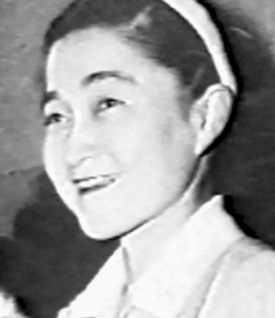
'Tokyo Rose' Was Innocent!
Iva Toguri d’Aquino was falsely identified as 'Tokyo Rose' and wrongly convicted of committing treason during WWII

Iva Toguri after Japan’s surrender 1
By Hans Sherrer
Published in Justice:Denied magazine, Issue 28, Spring 2005, pp. 22-25
(The PBS program "History Detectives" broadcast a segment on July 20, 2009 with new evidence that a key prosecution witness against Iva Toguri was bribed by the U.S. government. This information was discovered in May 2006 when the U.S. Dept of Justice released the files in response to a Freedom of Information Act request. You can view this program online at, http://video.pbs.org/video/1185284483/search/tokyo%20rose )
Preface
One of
the
twentieth-century’s most publicized criminal prosecutions was the
1949 trial of an innocent woman for treasonous conduct during WWII
radio broadcasts from Japan. That woman was publicly described as
‘Tokyo Rose.’ By deliberately presenting perjured
testimony, concealing exonerating documents and openly lying in court,
her prosecutors succeeded in publicly transforming a woman who should
have been hailed as a national heroine, into a convicted felon and a
figure of public scorn.
Although her trial was over five decades ago, Iva Toguri’s story
remains compelling because she is still alive, and it remains relevant
because the tactics of deception used by her prosecutors to pervert the
fair functioning of the judicial system to make an innocent woman
appear guilty are regularly used in state and federal criminal trials
across the country.
Introduction
It was news around the world when on September 29, 1949, the woman identified as the infamous ‘Tokyo Rose’ was convicted of treason against the United States. Found guilty of aiding the Japanese by making a radio broadcast during WWII that could have harmed U.S. troop morale, she was sentenced to ten years in prison. Yet her prosecution, conviction and imprisonment was an unconscionable travesty of justice. At the same time Justice Department prosecutors were publicly defaming the woman they called ‘Tokyo Rose’ to all of the world as a vicious blackheart, they were suborning witnesses to commit perjury and concealing evidence of her innocence. Her prosecutors successfully used smoke and mirror tactics to create the illusion the innocent woman on trial was guilty. For more than 25 years the federal government successfully concealed the truth: rather than being a traitorous siren, the woman prosecuted as ‘Tokyo Rose’ was a genuine American heroine who risked her safety to aid allied POWs in Japan and subvert Japanese efforts to undermine allied troop morale in the Pacific.
The Trial
On July 5, 1949 the trial began in San Francisco’s federal court of the woman known to the world as ‘Tokyo Rose.’ She was a U.S. citizen charged with treasonous conduct during WWII for allegedly voluntarily remaining in Japan after the war began and making radio broadcasts that betrayed the U.S. by “urging G.I.’s to lay down their arms.” 2
The trial of ‘Tokyo Rose’ was a major world media event that is on the short list of candidates for Trial of the Century. It lasted 13 weeks and cost $750,000, which was more than the government had spent prosecuting any person in U.S. history up to that time. After deliberating for 80 hours, on September 29th the jury returned not guilty verdicts on 7 of the 8 counts in the indictment. The one guilty verdict was for “speak[ing] into a microphone concerning the loss of ships.” 3 That count referred to her alleged broadcast of news about the Battle of Leyte Gulf in the Philippines in October 1944. 4
Eight days later, on October 6, 1949, U.S. District Judge Michael Roche sentenced ‘Tokyo Rose’ to 10 years in prison and fined her $10,000. Her release on January 28, 1956 after serving over 6 years at the Federal Reformatory for Women in Alderson, West Virginia, and a total of 8-1/2 years in custody, would seem to have closed the book on the infamous ‘Tokyo Rose.’
It would have except for two things: ‘Tokyo Rose’ never existed; and the woman accused, prosecuted, convicted and imprisoned of being her was innocent. That woman was Iva Toguri. (Her married name was Iva Toguri d’Aquino.)
Who Was Iva Toguri d’Aquino?
Born in Los Angeles on July 4, 1916 to parents that had immigrated to the U.S., Iva’s parents discouraged her from learning to read or write Japanese, so English was her sole language. An exceptionally bright young woman, Iva graduated from U.C.L.A. in 1940 with a bachelors degree in zoology. Her mother was diabetic and Iva planned to enter medical school and become a doctor.
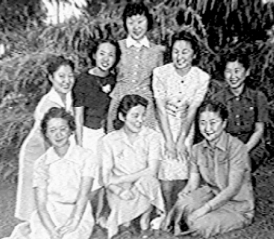
Iva with other members of the Chi Alpha Delta Sorority at UCLA (Iva is the young woman in the lower right hand corner)
In the summer of 1941, Iva traveled to Japan to be the familiy’s representative at the expected death of her ill mother’s only living sister. On July 5th the 25-year-old Iva left for Japan expecting to be gone for a year. Although she traveled without a passport or a visa, the U.S. State Department issued her a Certificate of Identification that she was told would allow her to travel to and from Japan.
After arriving in Japan, Iva was totally a fish out of water. She could neither read nor write Japanese, although she could passingly speak and understand it, and she was so out of touch with the culture that she didn’t even know how to use chopsticks.
In September Iva visited the U.S. Vice Counsel in Japan to apply for a passport, and her application was sent to the U.S. for processing. As relations rapidly deteriorated between the governments of Japan and the U.S., Iva made hasty arrangement in late November 1941 to return to the U.S. However, when she attempted to board a California bound ship on December 2, 1941, she wasn’t permitted to do so because the Certificate of Identification provided by the State Department wasn’t considered proof of her U.S. citizenship.
Iva found herself trapped in Japan when Pearl Harbor was attacked five days later. 5
After refusing the suggestion of Japanese government agents to renounce her U.S. citizenship, Iva had to move out of her aunt’s house when neighbors began suspecting she was an American spy, and neighborhood children jeered her as a horyo (“POW”) and threw stones at her. 6 Although Iva was considered an enemy alien, the government refused her request to be interned with other foreigners since she was thought harmless as a woman of Japanese heritage, and she was considered capable of providing for herself.
To survive in a country whose language she couldn’t read or write, Iva got a job teaching the piano to pay for Japanese language lessons. In the summer of 1942, when she was finally able to communicate in Japanese, Iva got a job paying 110 yen per month (about $5) transcribing English language radio broadcasts at Domei, Japan’s national news agency. 7 While working at Domei, Iva saw her family on a list of Japanese-Americans sent to Arizona’s Gila River Relocation Center.
Iva met her first real friend in Japan at Domei, Felipe d’Aquino, a Portuguese citizen of Japanese-Portuguese ancestry. Felipe was a radio monitor who shared her pro-American views. While at Domei Iva’s boardinghouse room was ransacked by the Kempeitai, Japan’s secret military police and counter espionage service. Iva again request to be interned with other foreigners, but the government denied her request since she was able to support herself.
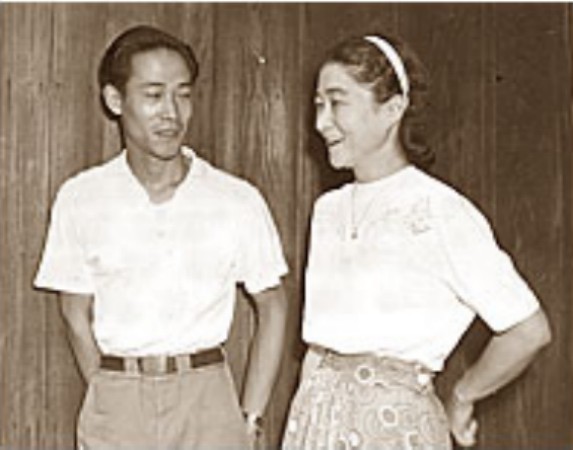
Felipe d’Aquino and Iva in 1945
The food rations in wartime Japan were so poor that Iva was hospitalized for six weeks in the summer of 1943 with pellagra, beriberi and malnutrition. In debt to Felipe the money she borrowed to pay her hospital bill and to the roominghouse where she was living, Iva went to work at Radio Tokyo in August 1943, after responding to a help wanted ad for a typist fluent in English. 8
The Zero Hour
In March 1943, the Japanese conscripted captured Australian radio personality Major Charles Hughes Cousens to start the Zero Hour program on Radio Tokyo. Broadcast in English from 6pm to 7:15pm everyday but Sunday, the Japanese intended it as a propaganda tool to undermine the morale of allied troops in the Pacific. However, Major Cousens planned to subvert the Zero Hour by using the program as a way to boost allied troop morale under the noses of the Japanese.
Prisoners of war U.S. Army Captain Wallace Ince and Filipino Lieutenant Norman Reyes, were also conscripted to work on the Zero Hour with Cousens. The three were able to take over writing the show’s scripts by feigning difficulty understanding the copy written by Radio Tokyo’s writers. Once they began writing their broadcasts, Cousens, Ince and Reyes were able to slip double-entendres, innuendos and sarcastic references past censors into their broadcasts.
Iva gained the trust of the Zero Hour broadcast crew by smuggling food and medicine to them and other POWs. She was also the only Japanese-American working at Radio Tokyo who had not renounced her U.S. citizenship. Several months after the Zero Hour went on the air Cousens’ Japanese bosses told him to add a woman broadcaster. Suspecting all the English speaking women at Radio Tokyo were Kempeitai spies except for Iva, Cousens suggested Iva for the job and his Japanese superior agreed. Iva reluctantly joined the Zero Hour crew after Cousen’s assured her she would only have to read scripts prepared by him and she would not have to say anything against American servicemen. Working for 150 yen a month (about $7), Iva’s first broadcast was in November 1943. 9
Iva Joins The Zero Hour
When she first started broadcasting Iva used the radio name of “Ann,” and it was later expanded to “Orphan Ann.” That name was appropriate given her situation in Japan and that she grew up a fan of “Little Orphan Annie.” Cousens was able to make the Zero Hour into a news and entertainment program that reduced the Japanese’s desired propaganda into being harmless rhetoric and spirit lifting music. The four members of the Zero Hour audaciously used the Japanese's flagship radio station to wage war on them from behind enemy lines. 10 If the Japanese had known what the four were doing, they all could have been shot.
Iva tongue-in-cheek warned listeners during her 20 minute segment that it had “dangerous and wicked propaganda, so beware!” 11 An example of her program's innocuous tongue-in-cheek dialogue is:
“Hello there, Enemies! How's tricks? This is Ann of Radio Tokyo, and we're just going to begin our regular program of music, news and the Zero Hour for our friends – I mean, our enemies! - in Australia and the South Pacific. So be on your guard, and mind the children don't hear! All set? OK. Here's the first blow to your morale – the Boston Pops playing “Strike Up The Band!” (music)” 12
U.S. military personnel also credited Iva with slipping serious things into her broadcasts like air raid warnings in the guise of bragging about Japanese military superiority. After the war a member of a B-24 Squadron wrote that she made comments such as:
“Hi, boys, this is your old friend, Orphan Annie. I've got some swell records just in from the states. You'd better listen to them while you can, because late tonight our flyers are coming over to bomb the 43rd group when you are all asleep. So listen while you are still alive.” 13
In describing the warnings he credited Iva with broadcasting on her program, that same serviceman wrote: “Almost without fail, the Jap bombers would come over. She was a better air raid system than our own.” 14 Other pilots acknowledged the help they thought she provided by letting them know Tokyo’s weather conditions. 15
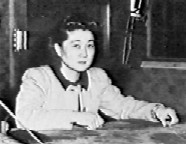
Iva broadcasting her Orphan Ann program from Radio Tokyo’s studio
As the war dragged on, the Zero Hour underwent many changes. In June 1944 Cousens had a heart attack, Ince was fired from the program for insubordination, and Reyes was looked upon as a “friendly alien” after Japan annexed The Philippines.
Iva had continued working at Domei after she started at Radio Tokyo, but she was fired from that job in the summer of 1944 for her openly pro-American views. When she found a replacement job at the Danish legation she attempted to resign from the Zero Hour, but her Japanese bosses refused to let her go.
After Cousens left the Zero Hour, Iva began writing her own scripts, modeling them after those he had written for her. In April 1945 Iva married Felipe d'Aquino, and she began to only sporadically show up to do her radio shift. The women that filled in for Iva during her frequent absences read the propaganda laden scripts written by Japanese personnel at Radio Tokyo.
In May 1945 the Kempeitai visited Iva and ordered her back to work at Radio Tokyo. She regularly hosted the “Orphan Ann” program from then until Japan’s surrender three months later in August 1945. During her 21 months on the Zero Hour, Iva broadcast a total of 340 programs. 16
Iva had every reason to expect she would be able to return to the U.S. soon after the war ended. After all, she was an American citizen refused passage to the U.S. before the war began; her requests to be interned with other trapped foreign nationals was rebuffed by Japanese authorities; although kept under scrutiny by the Kempetai she carried on a one woman war effort behind enemy lines by scavenging food and medicine for allied POWs; and she did everything possible to ensure her “Orphan Ann” radio program always boosted the spirits of allied servicemen.
Who Is ‘Tokyo Rose’?
Servicemen throughout the Pacific had adopted the moniker of Tokyo Rose to describe English speaking women broadcasters on Japanese radio stations. There were more than a dozen on Radio Tokyo alone. When the war ended, hundreds of reporters descended on Tokyo, and dozens combed the city trying to get the scoop on the greatest mystery and one of the hottest stories in postwar Japan: Who is the Tokyo Rose?
Two of the reporters wanting to get the Tokyo Rose scoop were Cosmopolitan magazine’s Harry Brundidge and Clark Lee of International News Service.
In post-war Japan the average income was about $80 per year, so the $250 reward Brundidge offered for information leading to Tokyo Rose was a veritable fortune. Brundidge also offered $2,000 – 25 years of income at the time – for an exclusive interview with ‘Tokyo Rose’. To collect the reward, a Japanese worker at Radio Tokyo identified Iva as the infamous ‘Tokyo Rose’. 17 To avoid being out-scooped, Clark Lee promptly reported to the world that the 29-year-old Iva was ‘Tokyo Rose’.
Iva was desperately in need of money and she knew that since there was no actual ‘Tokyo Rose’ she could claim to be her as legitimately as any other woman broadcaster at Radio Tokyo. In exchange for Brundidge’s agreement to pay her $2,000, Iva gave an interview that Lee recorded in 17 pages of notes. 18 Included in the notes of the interview was her statement she was “the one and original ‘Tokyo Rose’.” 19
However, Cosmopolitan rejected Brundidge’s article and refused to pay the $2,000 he had contracted to pay Iva without their authorization. So Brundidge was personally on the hook to pay her the money, which he didn’t want to do. His contract with Iva had an exclusivity clause, and to void it he enlisted the aid of 8th Army Counter Intelligence Corps (CIC) Commanding General Elliott Thorpe to arrange a press conference at the Yokohama Bund Hotel that was attended by over 100 reporters. 20 He also gave Lee’s interview notes to General Thorpe, telling him, “She’s a traitor and here’s her confession.” 21
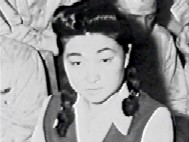
Iva at the Yokohama Bund Hotel press conference
Thinking she was a celebrity appreciated for her efforts to help the allied war effort from within the belly of the enemy, Iva freely answered questions during the press conference. She also gave interviews with Yank and Stars and Strips, signed autographs, and posed for pictures. 22 She told reporters, “I didn’t think I was doing anything disloyal to America,” and that she “never, never broadcast propaganda.” 23
The Post-War Imprisonment and Investigation of ‘Tokyo Rose’
On October 17, 1945 Iva was arrested at her Tokyo apartment by the CIC without a warrant or charges against her. It was nine weeks after Japan’s surrender, and she had been waiting to receive a visa to return to the U.S.. Jailed in the brig at 8th Army Headquarters, she wasn’t told why she was arrested, she was denied visits by her husband, and she was only allowed one bucket of hot water every three days to use for bathing and washing her clothes. 24
After a month Iva was transferred to Sugamo Prison in Tokyo. For the next 11-1/2 months she was caged in a 6’ x 9’ cell, permitted to bathe once every three days, and allowed to have a single 20-minute visit with her husband, Felipe, on the first day of each month. 25 Iva had no privacy, and once several visiting members of Congress voyeuristically peered in on her as she was bathing. While at Sugamo, Iva learned that her mother had died enroute to the internment camp in Arizona, and that after being released when the war ended, her family had relocated to Chicago.26
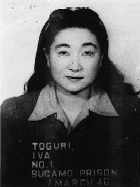
Iva’s “mug shot” at Sugamo Prison
During the time Iva was at Sugamo Prison, Charles Cousens, the Australian Major who had recruited her to work on the Zero Hour, was tried for treason by the Australian Army for his work on that program. 27 After his acquittal he returned to his prewar job of working for Radio Sydney.
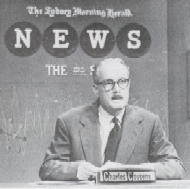
Charles Cousens after the war on Sydney, Australia TV station Channel Seven
Also while she was at Sugamo Prison, Army Captain Wallace Ince was not only cleared after a U.S. military investigation of having acted treasonously by working on the Zero Hour, but he was promoted to Major. 28

Captain Wallace Ince
Iva
continued languishing in Sugamo Prison being relentlessly
interrogated by the FBI and the Army CIC, even though all evidence
pointed to neither her nor anyone else being Tokyo Rose. 29
It was simply a catchy name used by U.S. servicemen to describe
English speaking women on Japanese radio broadcasts, and it
didn’t
refer to any one of them in particular. Neither was any evidence
found of her having done anything treasonous during her 21 months on
the Zero Hour.
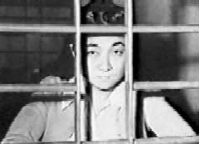
Iva in her cell at Sagumo Prison
After being imprisoned for more than a year without any charges filed against her, Iva was suddenly and unconditionally released on October 25, 1946. 30 Her release was a major media event and reporters from all the world’s major news services were present as she left the prison. 31
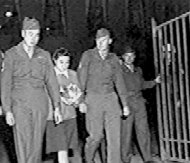
Iva is released from Sagumo Prison on October 25, 1946 after being imprisoned without charges for more than a year.
Wanting to return to the U.S., Iva found that the same lack of documentation that had trapped her in Japan before the war interfered with her getting a passport. After she had waited more than a year, the State Department issued a ruling that it had “no objection at all” to her being issued a passport. 32
When it became known in the U.S. that her return was imminent, a number of people expressed opposition, but none more vocally than Walter Winchell. From his bully pulpit as the most powerful newspaper columnist and radio commentator of his time, Winchell didn’t just call for Iva to be kept out of the country, he demanded that she be prosecuted for treason. Joining in the chorus of “let’s get Iva,” J. Edgar Hoover requested the help of anyone who could assist the FBI in proving she was ‘Tokyo Rose.’ 33
Then working for the Nashville Tennessean, Harry Brundidge answered Hoover’s request for assistance. In March 1948 he went to Tokyo to assist the FBI and the Justice Department build a case against Iva by inducing her to sign Clark Lee’s notes of the interview she gave in 1945 as authentic. 34 She had never been told Brundidge was the “rat” behind her arrest in October 1945, and he feigned being her friend. 35 He assured Iva that if she signed the notes it would speed up her return to the U.S.
She resisted signing them, telling him, “Most of this is made up,” including that she was ‘Tokyo Rose’. 36 Brundidge knew what was in the notes was largely a figment of her imagination, and that she had told Lee and him what they wanted to hear in exchange for the desperately needed $2,000 – which she was never paid. Brundidge persisted and perhaps due to the emotional strain of having had her baby die the day after it was born two months previously, combined with wanting to be reunited with her family after a seven year separation, combined with her then 2-1/2 year effort to return to the U.S. after the end of the war, Iva caved in and signed the notes.
Two months after returning to the U.S., Brundidge openly betrayed Iva to further his career by publishing a 10-part series portraying Iva as ‘Tokyo Rose’ and a traitor. The first part was titled: Arrest of “Tokyo Rose” Nears: She Signs Confession to “Sell-Out.” 37 His betrayal of Iva didn't stop at publicly smearing her with what he knew were lies.
For the second time Harry Brundidge was the key figure in a catastrophe in Iva’s life when five months after he badgered her into signing Lee’s notes, the Justice Department used them to indict her for treasonous conduct. 38 In August 1948 she was arrested by military police at her apartment in Japan. She was finally granted her wish to return to the U.S. on September 25, 1948. However it was under a military escort, and when Iva arrived in San Francisco she was arrested by the FBI as an accused enemy of the United States. 39
The Trial – Part II
When Iva’s trial began on July 5, 1949 she had already spent 11 months in custody since her arrest in Japan. She was denied bail, and after her arrival in the U.S. one irregularity was the FBI took her out of the San Francisco Jail where she was being held and attempted to interrogate her without her lawyer being present. He learned about it and was able to intercede and stop the illegal interrogation. 40 When the defense uncovered evidence the government relied on the perjured testimony of a grand jury witness to obtain Iva’s indictment, U.S. District Court Judge Michael Roche ruled it was harmless error because the witness wasn’t a trial witness. 41 Judge Roche also barred the jury from being exposed to any evidence about Iva’s efforts on behalf of allied POWs, ruling it was irrelevant to the treason charges. 42
Forty six witnesses testified for the government, including sixteen brought from Japan. 43 Two of the witnesses brought from Japan, Kenkichi Oki and George Mitushio, were California born Japanese-Americans who were superiors of Iva’s at Radio Tokyo. 44 The men, who had renounced their U.S. citizenship during the war, testified that Iva made treasonous statements during broadcasts after the U.S. Naval victory at the Philippines Leyte Gulf in October 1944. 45
Unlike the free spending of multiple federal agencies focused on convicting her, Iva’s meager defense was paid by her father with borrowed money. 46 Her three lawyers, headed by Wayne Mortimer Collins, donated their months of time to defend her. 47 It helped that Charles Cousens paid his own expenses to travel from Australia to San Francisco to testify for Iva. 48 Wallace Ince also paid his own travel expenses to testify for her. The third male member of the Zero Hour broadcasting team, Norman Reyes, also testified on Iva’s behalf. When he did so he recanted earlier testimony as a prosecution witness, stating it had been coerced from him by federal prosecutors. 49 A total of twenty-six witnesses testified during Iva’s defense. 50
By the time Iva testified on her own behalf in September 1949, she had been jailed for 13 months. Looking “pale” and “haggard,” she asserted her innocence of doing anything that could be considered treasonous or that harmed the Allies war effort. 51
The government’s case against Iva revolved around convincing the jurors that Iva had encouraged American servicemen to stop fighting, that she choose to stay in Japan after the war began, that she “maliciously betrayed the United States,” and that she was ‘Tokyo Rose’. 52 Although the jury didn’t know it, Iva could not have been ‘Tokyo Rose’ because on December 11, 1941 an entry was made in a U.S. submarine’s log book describing an English speaking woman on a Japanese radio broadcast as ‘Tokyo Rose.’ 53 That was nine days after Iva had been refused passage back to the U.S, four days after the attack on Pearl Harbor, and 23 months before Iva began broadcasting the Orphan Ann program on Radio Tokyo. A month later, in January 1942, another U.S. submarine (the Seawolf) made an entry in its log book refering to a different English speaking Japanese broadcaster as ‘Tokyo Rose.’ 54
Even with the withholding of evidence from the jury favorable to Iva, few witnesses to the trial expected Iva to be convicted of any of the eight counts. Nine out of ten reporters informally polled thought she would be acquitted. After the jury had failed to reach a verdict after days of deliberations, Judge Roche refused to declare a mistrial. To help break the deadlocked jury, he gave an “Allen” instruction to the jury that the trial had cost the government over half a million dollars, and that they should continue deliberating until they arrived at a verdict. 55 Finally, on September 29th after 80 hours of deliberations they acquitted Iva of seven treason counts, and found her guilty of one:
“That on a day during October, 1944, the exact date being to the Grand Jurors unknown, said defendant at Tokyo, Japan, in a broadcasting studio of the Broadcasting Corporation of Japan, did speak into a microphone concerning the loss of ships.” 56
That the jury submitted to the judge’s pressure to come to a verdict by settling on finding Iva guilty of that count was particularly odd considering its vagueness. It didn’t specify the day or time the alleged broadcast took place, or whether it referred to the loss of Japanese or U.S. ships, or both.

Newsclipping of Iva Toguri d’Aquino’s treason conviction on September 30, 1949. Written by S.F. Chronicle columnist Stanton Delaplane, on August 2nd during Iva’s trial he had written of her broadcasts: “On the face of it, none of the material seemed particularly vicious.” 57
Iva was the seventh person convicted of treason in this country’s history. The minimum sentence for treason was five years and the maximum was death. On October 6, 1949 Judge Michael Roche sentenced her to 10 years in prison and a $10,000 fine.
Imprisonment and Return To Regular Life
Iva lost her appeal, and the U.S. Supreme Court twice declined to review her conviction. She was a model prisoner at the Federal Reformatory for Women in Alderson, West Virginia. Her husband Felipe was a Filipino, and the federal government barred him from entering the U.S., so they were only able to correspond by letters.
On January 28, 1956 Iva was released from prison on parole. However her ordeal wasn’t over. Although she had been born in the U.S., and she had attended and graduated from UCLA as a native Californian, an agent of the U.S. Immigration Service served a warrant for her deportation as she left the prison. After veterans and other groups and people publicly expressed opposition to Iva’s deportation, the government backed off from actively pursuing execution of the warrant. In 1958 the Immigration Service announced it was ceasing efforts to deport Iva. 58

Iva interviewed before the beginning of her first INS deportation hearing in March 1956.
Iva’s parole ended on April 18, 1959. Although she was stigmatized by being a felon convicted of treason, her more than 18 year odyssey to return to her family and freely resume her life in the U.S. — that began with the refusal to let her board the U.S. bound ship on December 2, 1941 — was finally over. She had spent a total of 8-1/2 years in jails and prisons, and more than 3 years on parole. She was jailed for a year by the military from October 1945 to October 1946; she was jailed for 1 year and 2 months from her arrest in August 1948 through her sentencing in October 1949; and she was imprisoned for 6 years and 4 months from October 1949 to January 28, 1956. Her $10,000 fine was paid out of her father’s estate when he died in 1972.
The Government’s Knowledge of Iva’s Innocence Is Disclosed
Iva made two applications for a Presidential pardon that were ignored: one was submitted to President Eisenhower in 1954 while she was still imprisoned, and the other was to President Johnson in 1968. At that time Iva simply didn’t have the hard evidence to support a pardon.
That changed in 1976, when two independent efforts converged to provide the documentary and testimonial proof that Iva was not only innocent, but the federal prosecutors misled the jury, her lawyers and the world at large by concealing proof of her innocence and suborning witnesses to perjure themselves in court.
In the early 1970s Ron Yates with the Chicago Tribune took an interest in Iva’s case after receiving a letter from a reader. In 1976 while the Tribune's correspondent in Tokyo, Yates tracked down the two men, Kenkichi Oki and George Mitushio, who had provided the critical testimony about the lone count of treason Iva had been convicted of. During a meeting at a Tokyo restaurant, both men admitted to Yates that Iva did not make the treasonous broadcast they testified to at her trial, and that they perjured themselves under pressure by the federal prosecutors. 59
Complementing Yates’ findings were the discoveries of a San Francisco filmmaker, Antonio Montanari, Jr. He accidentally stumbled across Iva’s case in 1972 while researching U.S. Army Intelligence’s belief during WW II that Amelia Earhart was ‘Tokyo Rose.’ 60 His curiosity piqued by Iva’s conviction in spite of a lack of evidence against her, Montanari submitted requests under the newly enacted Freedom of Information Act of 1974 with the Justice Department, the FBI and U.S. Army Intelligence for documents about her case. Two years later he obtained over 2,300 documents from those agencies. 61
By the fall of 1976 it had been learned that before the war ended, and more than four years prior to the start of her trial, the U.S. Office of War Information determined, “There is no Tokyo Rose; the name is strictly a G-I invention. ... Government monitors listening in twenty-four hours a day have never heard the words Tokyo Rose over a Japanese-controlled Far Eastern radio.” 62 Already knowing she was not Tokyo Rose, “Six months after Iva’s arrest, the Eighth Army’s legal section reported, “There is no evidence that [Iva Toguri d’Aquino] ever broadcast greetings to units by names or location, or predicted military movements or attacks indicating access to secret military information and plans, etc., as the Tokyo Rose of rumor and legend is reported to have done.” 63 The office of the U.S. Attorney General was aware of this report, and it was their recognition that “the identification of Toguri as ‘Tokyo Rose’ is erroneous,” that led to her rapid release from custody on October 25, 1946. 64 Yet less than two years later, United States Attorney General Tom Clark authorized Iva Toguri d’Aquino to be indicted for treason by federal prosecutors who knew she was not Tokyo Rose and that she had never committed treason. Federal prosecutors and other government agents continued the charade by concealing their knowledge of her innocence all through her trial, her appeals process, and while the Immigration Service attempted to deport her after she had finished her prison sentence.
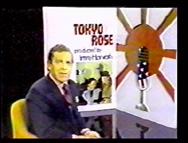
Morley Safer introducing the June 24, 1976 60 Minutes segment on Iva
Yates wrote several articles about Iva’s case for the Chicago Tribune that contributed to the production of a segment about Iva for CBS’ 60 Minutes television program. During that segment aired on June 24, 1976, one of the CIC officers that had interviewed Iva in 1945, George Guysi, said that the U. S. State Department had simply abandoned her in Japan. John Mann, the foreman of her trial jury, said he always believed she was innocent of all the charges, but he submitted to the pressure of the other jurors and the judge by voting guilty on the one count she was convicted of. 65 During an interview with Morley Safer aired on that program, Iva alluded to her role as a media generated sacrificial lamb: “I suppose, if they found someone and got the job over with, they were all satisfied. It was Eeny, Meeny, Miney ... and I was Moe.” 66
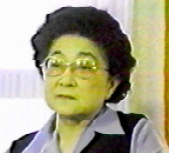
Iva during her interview aired on 60 Minutes
With the publicity generated by the revelations of recanted testimony and the prosecutors concealment of evidence supporting Iva’s innocence, support began to build for Iva’s pardon.
Iva’s Pardon
In November 1976 Wayne Merrill Collins, the son of Iva’s lead trial lawyer filed a presidential pardon petition for Iva. The public disclosures supporting her innocence were so convincing by that time, that on January 19, 1977, in one of his last acts prior to leaving office, President Ford agreed with the recommendation of U.S. Attorney General Edward Levi, and pardoned Iva. She is the only person convicted of treason in this country that has been pardoned.
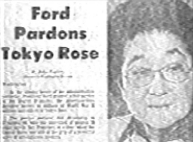
Newspaper story about President Ford’s pardon of Iva on January 19, 1977
However, Iva has not been compensated for her wrongful conviction and imprisonment, the $10,000 fine taken from her father’s estate has not been repaid, and neither her contributions to helping allied POWs in Japan during the war nor the risks she took by using her Zero Hour radio program to bolster allied troop morale have been officially recognized. Yet she did those things and took those personal risks while high military “leaders” spent the war in relative safety piling up undeserved medals, promotions and noteriety.
There is no shortage of villains who had roles in Iva Toguri d’Aquino’s 18 year ordeal from December 2, 1941 when U.S. officials refused to let her board a California bound ship, to April 18, 1959 when her parole ended.
There are the nameless and faceless State Department bureaucrats who issued the Certificate of Identification she used to travel to Japan in July 1941 but which was inadequate for her to return to the U.S. and trapped her there during and after the war.
There is the Radio Tokyo employee that identified Iva to Harry Brundidge and Clark Lee as ‘Tokyo Rose’ for the $250 reward — knowing she wasn’t.
There is Harry Brundidge for his three unconscionable betrayals of Iva. The first led to her arrest on October 17, 1945 for what was subsequently found to be the baseless accusation she was ‘Tokyo Rose,’ the second was his smearing of her as the traitorous ‘Tokyo Rose’ in his 10-part newspaper series in 1948, and the third led to her equally baseless prosecution and wrongful conviction of treason. Amazingly Brundidge continued slandering Iva while she was in prison. The January 1954 issue of The Mercury featured an article by him, America’s First Woman Traitor. 67 It is a mystery why Harry Brundidge, who died in 1960, had such a venomous hatred of Iva.
There is Army General Elliott Thorpe for allowing the U.S. Army to be used to get Harry Brundidge off the hook to pay Iva $2,000 for the interview she gave Clark Lee and him, and then having her arrested and imprisoned without charges for more than a year beginning on October 17, 1945.
There is federal Judge Michael Roche for his blatant pro-prosecution bias during Iva’s trial that was essential for the jury to wrongfully convict her. 68
There are the Department of Justice attorneys who staged the elaborate charade of Iva’s prosecution knowing all the while she was innocent, and who stood silently by as she was wrongly convicted, sentenced and hauled away to prison for over 6 years. The lead federal prosecutor in Iva’s case displayed the same cowardice it took for him to participate in the framing of an innocent Iva when he committed suicide by shooting himself at age 56 – two months after Iva’s parole ended in April 1959. 69
There are the federal agents in the Immigration Service who sought to deport her after her release from prison – even though she is a native born American.
There are the hundreds of military personnel, employees of the FBI, the U.S. Attorney’s Office, and other federal agencies who although knowing Iva was innocent, remained silent and failed to come to her aid. To their everlasting shame and infamy, they remain silent to this day.
There are also many people who noticeably went out of their way to help and support Iva, including her husband Felipe d’Aquino, Norman Cousins, Wallace Ince, Wayne Mortimer Collins and his son Wayne Merrill Collins, her father and other family members. 70 However, they were powerless to stop the government’s fevered juggernaut to have Iva falsely branded as a traitor. It wasn’t until reporter Ron Yates, filmmaker Antonio Montanari, Jr. and others were able to publicly uncover the perjury suborned by federal prosecutors and their concealment of her innocence that she was pardoned in 1977.

The Toguri family in 1941 before Iva left for Japan. (left to right) June, Inez, Fred, Iva, Jun (dad), Fumi (mom-center). After relocating to Chicago, the family founded the J. Toguri Mercantile Co, which on March 29, 2003 was recognized during the annual Japanese American National Museum dinner in Los Angleles as one of seventy-one 3-generation Japanese-American businesses in America, and the only one in Illinois.
Through it all, Iva maintained her dignity and didn’t reduce herself to the base level of those who caused her so much pain or used her misfortune to their own advantage. As her father, Jun Toguri said to her on September 25, 1948 when he saw her for the first time in over seven years: “Girl, I’m proud of you! You didn’t change your stripes. A tiger can’t change his stripes, but a person so easily can.” 71
After their release from the Gila River Relocation Center, the Toguri family relocated to Chicago. The family founded the J. Toguri Mercantile Co, which on March 29, 2003 was recognized during the annual Japanese-American National Museum dinner in Los Angleles as one of seventy-one 3-generation Japanese-American businesses in America, and the only one in Illinois. After her release from federal prison, Iva moved to Chicago and joined in operating the family business.
A fact based dramatic movie of Iva’s life is in the planning stages, and it will enable this and future generations of American’s to be inspired by her courage in the face of unconscionable mistreatment and incredible adversity.
Iva Toguri d’Aquino — the innocent heroine who stood her ground while being shamelessly, dishonorably and wrongly treated for years by military investigators, FBI agents, federal prosecutors, a federal judge, immigration authorities and unscrupulous reporters — is 89 years old and lives in Chicago. [Note: After this article was published, Iva died at the age of 90 on September 26, 2006.]
(Authors
Note: This article was sent to Iva Toguri d’Aquino so she could
respond with any factual corrections that she considered necessary. I
want to acknowledge that the archivist of Iva’s personal papers,
Barbara Trembley, and Ron Yates reviewed it for accuracy at Iva’s
request.)
Endnotes
1 Photo of Iva Toguri’s taken on September 4, 1945 after a press conference at the Yokohama Bund Hotel. Published in Pacific Stars and Stripes magazine.
2 They Called Her Traitor, J. Kingston Pierce, American History, October 2002, pp. 22, 28.
3 Id. at 22, 28.
4 Later in this article, in The Trial – Part II, it is noted that Iva couldn’t have reported such a loss of ships because the U.S. didn’t lose any in that battle.
5 Approximately 10,000 U.S. born Japanese-Americans were likewise trapped by circumstances in Japan. See e.g., They Call Her Tokyo Rose, Keith O’Brien, January 20, 1998, http://www./wire.com/01-20-98/Chicago_cover.html. The ship Iva was refused passage on, the Tatsata Maru, was a Japanese vessel forced to turn back in mid-voyage and return to Japan.
6 Suspicions were aroused by the Special Security Police’s (Tokko Keisatsu) interrogation of Iva twice a week at her aunt’s home for several months. They suggested that Iva’s registration as a Japanese citizen would end her harassment. Iva eventually requested the permission of her relatives to move out, to avoid the embarrassment of them evicting her. Source: email from Ron Yates to Barbara Trembley, May 20, 2003.
7 They Call Her Tokyo Rose, supra.
8 Radio Tokyo was officially known as NHK - Nippon Hoso Kyokai.
9 They Called Her Traitor, supra, at 22, 25.
10 Id. at, 22, 25. This was broadcast on February 22, 1944.
11 Id. at, 22, 26.
12 Id. at, 22, 26.
13 A letter from Robert W. "Bob" White, 65th SQ, to Aerial Gunners Association Magazine http://www.kensmen.com/tokyoroseb.html
14 Id.
15 There is some controversy about whether Iva gave the warnings of impending bombings and provided weather conditions over Tokyo to American pilots that U.S. serviceman have credited her with providing. However, the men that have done so had no association with Iva, and their gratitude is a real part of Iva Toguri’s lore: If Iva gave the warnings she saved the lives of American servicemen, and if she didn’t they thought she was and acted accordingly to protect themselves. So either way the lore of Iva’s warnings to American servicemen undermines allegations of treasonous conduct later made against her. Also, in the late 1950s WW II veterans became some of Iva’s staunchest spporters in opposing her deportation from the U.S.
16 Bill Kurtiss’ 1969 radio documentary about Iva Toguri at: http://www.earthstation1.com/Tokyo_Rose.html
17 The person at Radio Tokyo who pointed out Iva as 'Tokyo Rose’ is identified as Kenkichi Oki in They Called Her Traitor, supra, at 22, 26. What is undisputed is the person who identified Ivas as Tokyo Rose worked with her at Radio Tokyo.
18 Orphan Ann Home Page, Section III. at: http://www.dyarstraights.com/orphan_ann/rosehunt.html
19 Id.
20 Id.
21 Id.
22 Id.
23 They Called Her Traitor, supra, at 22, 26.
24 Orphan Ann Home Page, Section III. supra.
25 Iva Toguri was imprisoned at Sugao mo Prison from November 16, 1945 to October 25, 1946.
26 Orphan Ann Home Page, Section III. supra.
27 Id.
28 Id.
29 Id.
30 Id.
31 Id.
32 They Called Her Traitor, supra, at 22, 27.
33 Id. at 22, 28.
34 Id. at 22, 27.
35 Id. at 22, 28.
36 Id. at 22, 28.
37 Orphan Ann Home Page, Section IV. at: http://www.dyarstraights.com/orphan_ann/rosehunt.html
38 They Called Her Traitor, supra, at 22, 28.
39 They Called Her Traitor, supra, at 22, 28. See also, Tokyo Rose: Famous Cases, FBI website, http://www.fbi.gov/libref/historic/famcases/rose/rose.htm
40 Orphan Ann Home Page, Section IV, supra.
41 Id.
42 Id.
43 Tokyo Rose: Famous Cases, supra.
44 They Call Her Tokyo Rose, supra.
45 Id.
46 They Called Her Traitor, supra, at 22, 28.
47 They Called Her Tokyo Rose, Rex B. Gunn, self-published, 1977, at 106. It is also noteworthy that in 1944, Iva’s lead lawyer, Wayne Collins, unsuccessfully argued before the Supreme Court in Korematsu v. U.S., 323 U.S. 214 (1944) that the removal of 110,000 Japanese-Americans to internment camps was unconstitutional. Michi Wegly’s book, Years of Infamy: The Untold Story of America's Concentration Camps was dedicated to Wayne Collins. She stated he “did more to correct a democracy's mistake than any other one person.”
48 They Called Her Traitor, supra, at 22, 28.
49 Orphan Ann Home Page, Section IV. supra.
50 Tokyo Rose: Famous Cases, supra.
51 They Called Her Traitor, supra, at 22, 28.
52 They Called Her Traitor, supra, at 22, 28.
53 They Called Her Tokyo Rose, supra, at 1. Mr. Gunn also mentions that the earliest known reference to Tokyo Rose prior to the war, was in 1937, when military construction workers in the Pacific used the name to describe an English speaking woman on a Japanese radio broadcast.
54 Id. at 2.
55 Orphan Ann Home Page, Section IV, supra.
56 Tokyo Rose: Famous Cases, supra.
57 Email from Ron Yates to Barbara Trembley, May 20, 2003.
58 They Called Her Tokyo Rose, supra, at 101-102; and, They Called Her Traitor, supra, at 22, 28.
59 See e.g., They Call Her Tokyo Rose, supra.
60 U.S.A. vs. ‘Tokyo Rose’, SAGAzine, http://www.sagazine.com/tokyorose.htm
61 Id.
62 They Called Her Traitor, supra, at 22, 26. (emphasis added)
63 Id. at 22, 27.
64 Id. at 22, 27.
65 Id. at 22, 28.
66 Orphan Ann Home Page, Section III, supra.
67 They Called Her Tokyo Rose, supra, at 102.
68 The prosecutors relied on Judge Roche’s favorable rulings to secure Iva’s wrongful conviction. Judge Roche’s pro-prosecution bias was reflected in his evidentiary and testimonial rulings that made Iva’s innocence of all charges less apparent to the jury. He not only contributed to concealing Iva’s innocence, but if he had declared a hung jury instead of pushing the jury to reach a verdict when it was clearly at an impasse, Iva’s ordeal would likely have ended in the fall of 1949 with the U.S. Attorney’s Office declining to retry her. After interviewing Judge Roche in 1958, AP reporter Katherine Beebe Pinkham observed what had been apparent to observers from his rulings in Iva’s case: his prejudice against her was so ingrained in him that he may not have been conscious to it. See They Called Her Tokyo Rose, supra, at 103-104; see also, Orphan Ann Home Page, Section IV, supra.
69 They Called Her Tokyo Rose, supra, at 109-110.
70 With Felipe barred from entering the U.S., and Iva afraid to leave the country for fear of not being readmitted, the last time the d’Aquino’s saw each other was in 1949 when Iva was tried. Corresponding monthly while she was in prison, they divorced in 1980, not having seen each other in 31 years.
71 Orphan Ann Home Page, http://www.dyarstraights.com/orphan_ann/suggest1.html